Submitted by WA Contents
Mies van der Rohe Foundation announces its programme of activities for 2023
Spain Architecture News - Feb 20, 2023 - 16:09 2634 views
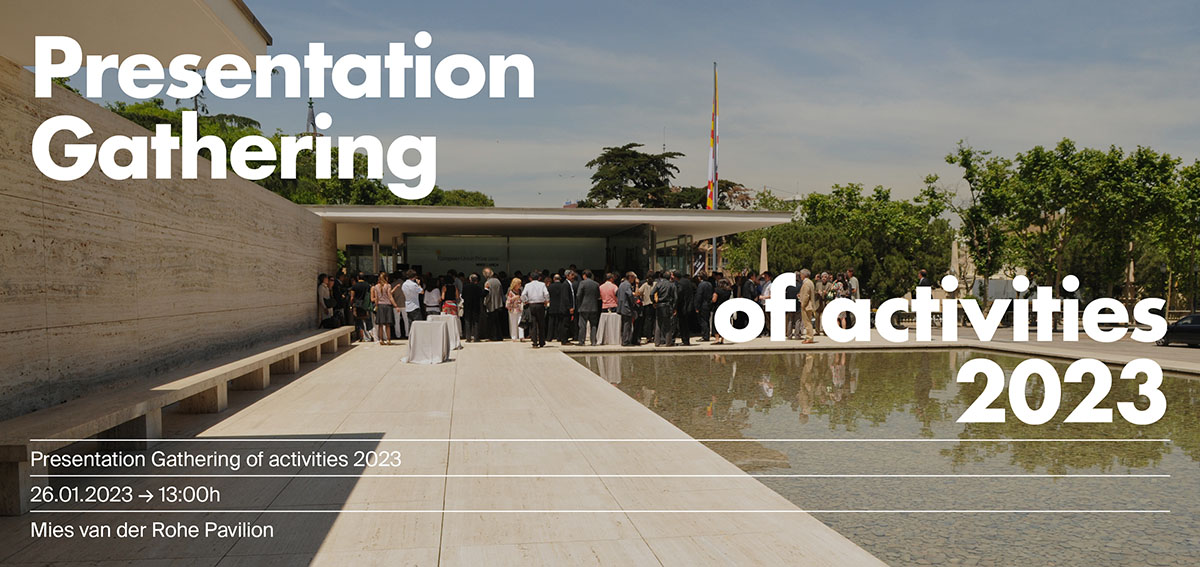
The Mies van der Rohe Foundation, in a meeting at the Pavilion open to everyone, has presented a program for 2023 that networks and welcomes and suggests new looks at architecture through the arts, debate and research.
Activities that will have local and international impact with the launch of the new edition of the European Union Prize for Contemporary Architecture/Mies van der Rohe-Young Talent Awards 2023, participation in the European cultural and architectural platforms LINA and New Temporalities, and the program of debates and artistic interventions in the Mies van der Rohe Pavilion.
The year has begun with the organization of the EUmies Awards in its Young Talent category with schools of architecture, landscape and urbanism from Europe and in this edition also from Africa. The process will culminate with an exhibition, debate and awards ceremony in Venice during La Biennale Architettura. The jury will select the best final projects that will allow us to discover how the new generations of architects are working to meet the most urgent challenges. In parallel, the EUmies Awards Architecture and Emerging 2022 exhibitions will continue their successful itinerancy with presence in Vienna, London, Ebeltoft (DK) and Copenhagen showcasing the best contemporary European architecture. Also included in the EUMies Awards program, the European conference Architecture & the Media will once again be a place to exchange experiences on the role of the media in the dissemination of architecture.
As a result of the collaboration with the European architecture platform LINA, three multidisciplinary teams have been chosen to contribute their proposals to the program of the Fundació Mies van der Rohe, as the winners of the EUmies Awards - Young Talent 2023 will participate with their proposals in the LINA meeting in Ljubljana giving them the opportunity to be invited by the other institutions of the platform. The collaboration with the New Temporalities platform will also make possible the exchange of creative proposals throughout 2023.
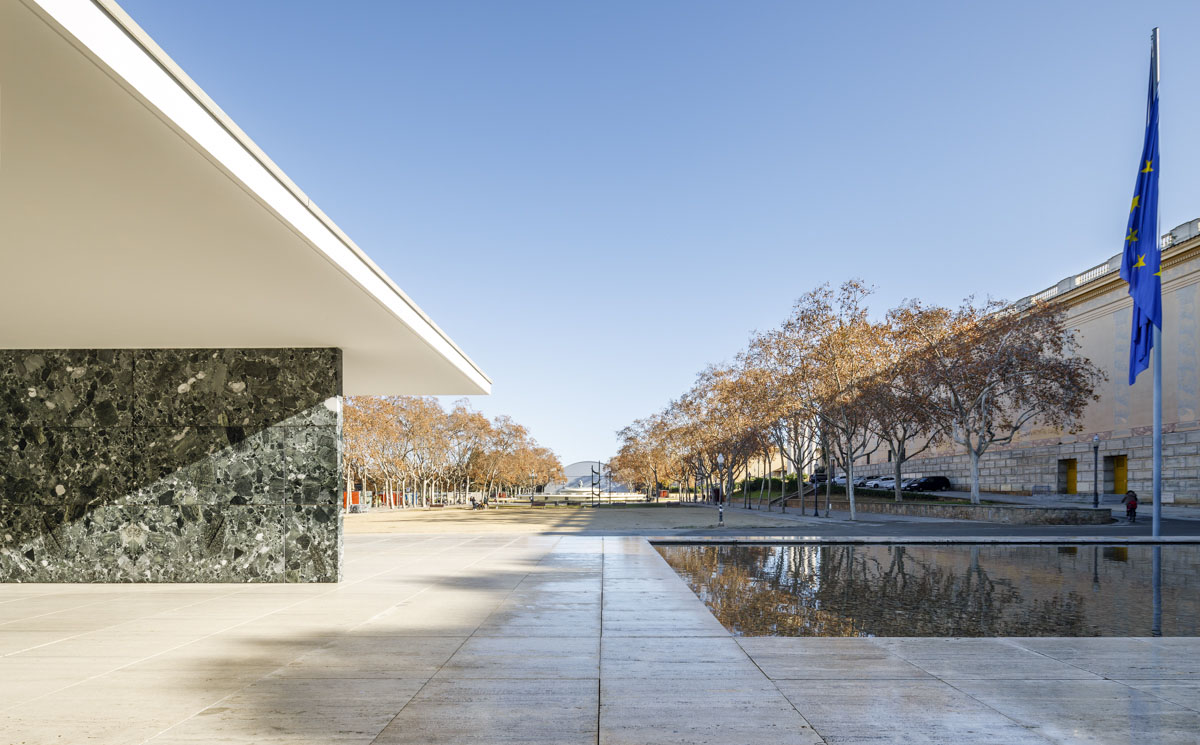
Mies van der Rohe Pavilion. Image © Marcela Grassi
The Fundació Mies van der Rohe, in its work to encourage and contribute to the dissemination of knowledge of architecture, collaborates with all the agents in the sector and contributes its experience to the Living Places Simon Architecture Prize and the Pavilion Workplace competition of USM and Adeyaka. And it will organize an exhibition at Construmat that will reflect on contemporary architecture based on the EUmies Awards archive.
The program of artistic interventions, generating new looks at architecture from the unique space of the Mies van der Rohe Pavilion will host this year very relevant proposals: "Rocking the Accident" where Stella Rahola and Roger Paez, with the students of the master MEATS of Elisava emphasize the effects of the passage of time on materials, thus closing the cycle initiated with "Beautiful Failures"; "The cost of money: raft" by Mark Cottle celebrates the International day free of plastic bags with two surfaces made of disposable bags collected in Barcelona and woven by hand that will occupy the space of the current carpet of the Pavilion and the large pond of the Pavilion. In autumn, three interventions will follow: "Psicoarquitectura" by Óscar Abraham Pabón during the Barcelona Gallery Weekend and Swab, and two proposals that contextualize the 1929 Pavilion, "El Marge" by Terence Gower that will revive the life of what used to be called Chinatown (now Raval) and "Politics and Architecture" by Dietrich Neumann that will reintroduce three little known elements of the Pavilion: the original flags, the plaque with the names of the companies that had participated in the construction of the Pavilion and the word "Germany" that was produced in steel and placed on travertine.
Pavelló de Música, Pantalla Pavelló i Pavelló de lectura bring music, film and literature to the Pavilion to be enjoyed with all the senses. This will be possible with the Barcelona Obertura concert, the new musical proposal of the Fundación Goethe and the collaboration with SónarMies.
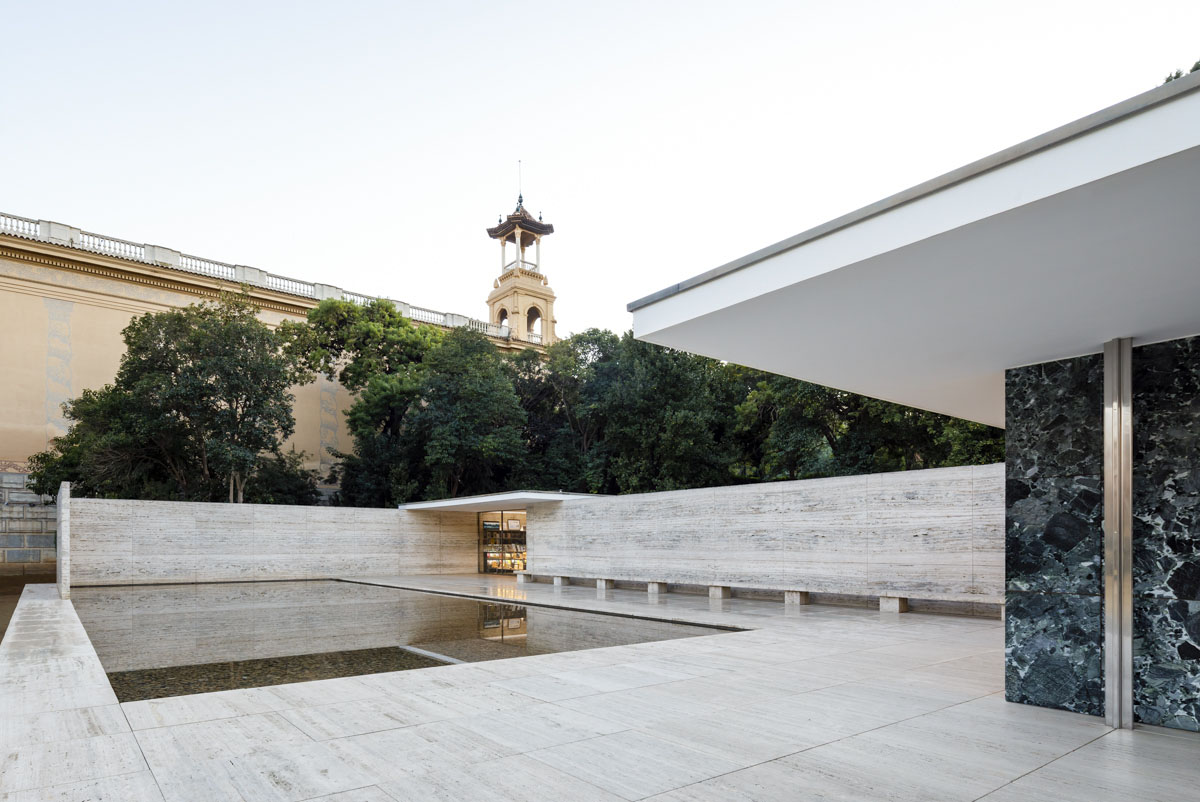
Mies van der Rohe Pavilion. Image © Marcela Grassi
In addition to participating in the programming of the cycle "Per amor a les arts" of the Filmoteca de Catalunya, the cinema arrives with the summer cycle Pantalla Pavelló which will be dedicated to Copenhagen, a recognition of its status as World Capital of Architecture this 2023.
Sant Jordi will be the opportunity to enjoy reading and especially the publication that we will present this year "The Stadium, The Pavilion and the Palace" by Domènec from the homonymous intervention that took place in 2018 in collaboration with MACBA. Two other publications will follow before the end of the year: "EUmies Awards - Young Talent 2023" and "Re-enactment: the work of Lilly Reich occupies the Barcelona Pavilion" by Laura Martínez de Guereñu.
The Fundació Mies van der Rohe will manage this year's Model. Barcelona Architectures Festival, which will bring together from April 20 to 30 a wide range of architecture, research and curatorial proposals that will be presented in mid-February at a special press conference.
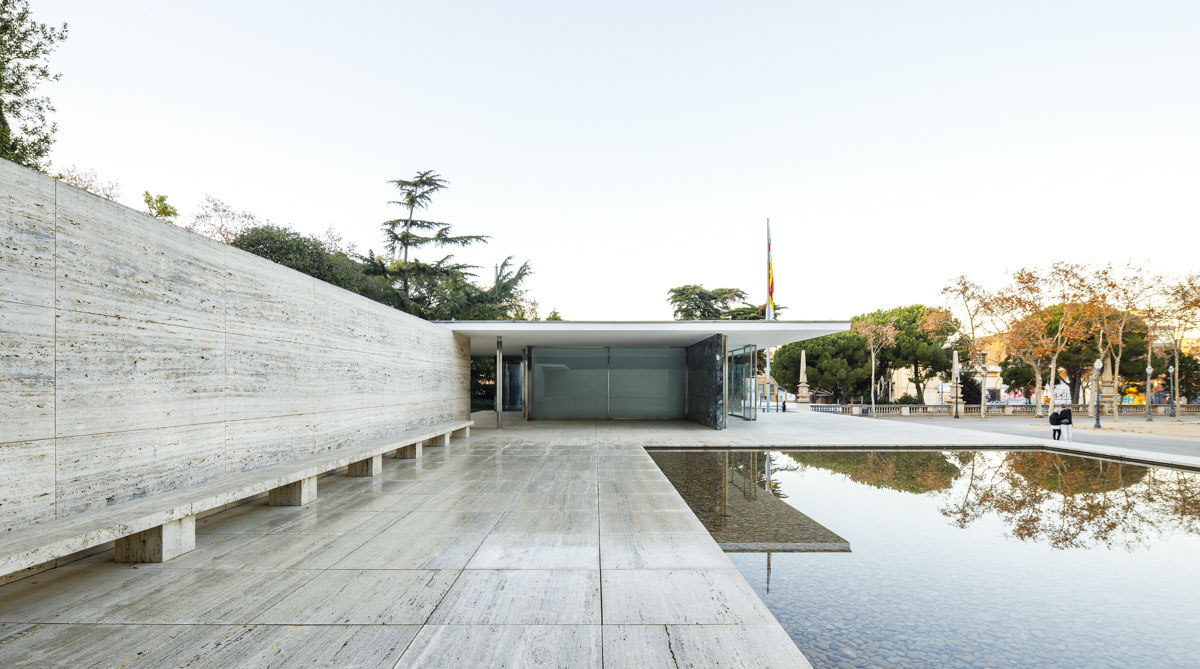
Mies van der Rohe Pavilion. Image © Marcela Grassi
Activities Calendar 2023:
EUmies Awards Exhibition, Architecture & Emerging 2022
- AzW, Vienna, until January 23rd
- Kingston University, London, from February 6 to March 3
- Maltfabrikken, Ebeltoft, April
- Danish Architecture Centre, Copenhagen, July 6 to 17
The exhibition of the European Union Prize for Contemporary Architecture / Mies van der Rohe Awards 2022, which opened in Barcelona, arrived with the Europas Beste Bauten exhibition at the Architekturzentrum Wien (Vienna) on October 5 and has been open to the public until January 23, 2023. It will then travel to London, hosting the award-winning building in the Architecture category, the Town Hall of Kingston University, followed by another of the selected buildings, the Maltfabrikken space in Ebeltof (Denmark). The Fundació will also participate with an exhibition at the Danish Architecture Centre in Copenhagen in the framework of the UIA World Architecture Congress and the UNESCO-UIA World Architecture Capital.
Living Places- Simon Architecture Prize
Awards Ceremony
Mies van der Rohe Pavilion
February
The Fundació Mies van der Rohe is sponsoring and contributing its experience for the fourth consecutive edition of the Living Places - Simon Architecture Prize and will host the awards gala at the Mies van der Rohe Pavilion to recognize the winners in both categories. In addition, as a new feature of this edition, the best audiovisual narration will be selected and the authors will be commissioned to produce a new audiovisual piece on architecture.
Presentation of the Publication “The Stadium, the Pavilion & the Palace” by Domènec
Mies van der Rohe Pavilion
February
A new publication with texts and photographs following the intervention "Domènec. L’estadi, el pavelló i el palau" that the Mies van der Rohe Pavilion hosted in April and May 2018, as part of the exhibition "Domènec. Ni aqui ni enlloc" at MACBA, is added to the collection of publications of the Fundació Mies van der Rohe.
Domènec, a visual artist who reflects on the political strategies of historical memory and social empowerment, makes a reflection on the image we have of the mountain of Montjuïc resulting from the international exhibition of 1929, and contrasts it with the social reality of this place just after and we could say until the reconstruction of the Mies van der Rohe Pavilion in 1988. The Belgian Pavilion, the Palace of the Missions and the Olympic Stadium sheltered people without resources who lived in a provisional way, as Huertas Claveria writes in the magazine Destino in 1966.
Lilly Reich Scholarship for Equality in Architecture
Presentation of the results of high school research work
Mies van der Rohe Pavilion
February
On the occasion of International Women's Day, the results of the current edition of the Lilly Reich Scholarship for Equality in Architecture and the announcement of its new edition will be presented at the Mies van der Rohe Pavilion. At this meeting, the students who won the Lilly Reich Scholarship for high school research work will present the results of their projects.
“Per amor a les arts”
The Grand Budapest Hotel - Wes Anderson
Filmoteca de Catalunya
March 21
The Mies van der Rohe Foundation joins forces with the Filmoteca de Catalunya to disseminate architecture to new audiences through cinema by proposing two films for the "Per Amor a les Arts" 22- 23 cycle, which includes proposals from other major cultural institutions in the city. Our proposal for this year is The Grand Budapest Hotel by Wes Anderson and the session will be presented by an expert with the aim of encouraging dialogue between architecture and cinema as a universal language.
Pavelló de Música
Barcelona Obertura, Diogenes Quartett
Mies van der Rohe Pavilion
March 25th
The Mies van der Rohe Pavilion regularly hosts concerts and invites you to enjoy music in this space that makes it special. The collaborations with the Conservatori de Música del Liceu, Barcelona Obertura and the Fundación Goethe have allowed a stable program of quality in recent years. On this occasion we can enjoy the interpretation of works by Amy Beach, Egon Wellesz and Wilhelm Kienzl by the Diogenes quartet formed by Stefan Kirpal and Gundula Kirpal on violins, Alba González y Becerra on viola and Stephen Ristau on cello.
Model. Barcelona Architectures Festival
from April 20 to 30
The second edition of Model. Barcelona Architectures Festival will be a space for reflection and celebration that will bring us closer to experimental architecture and invite us to rethink how we want to live together through new models of city.
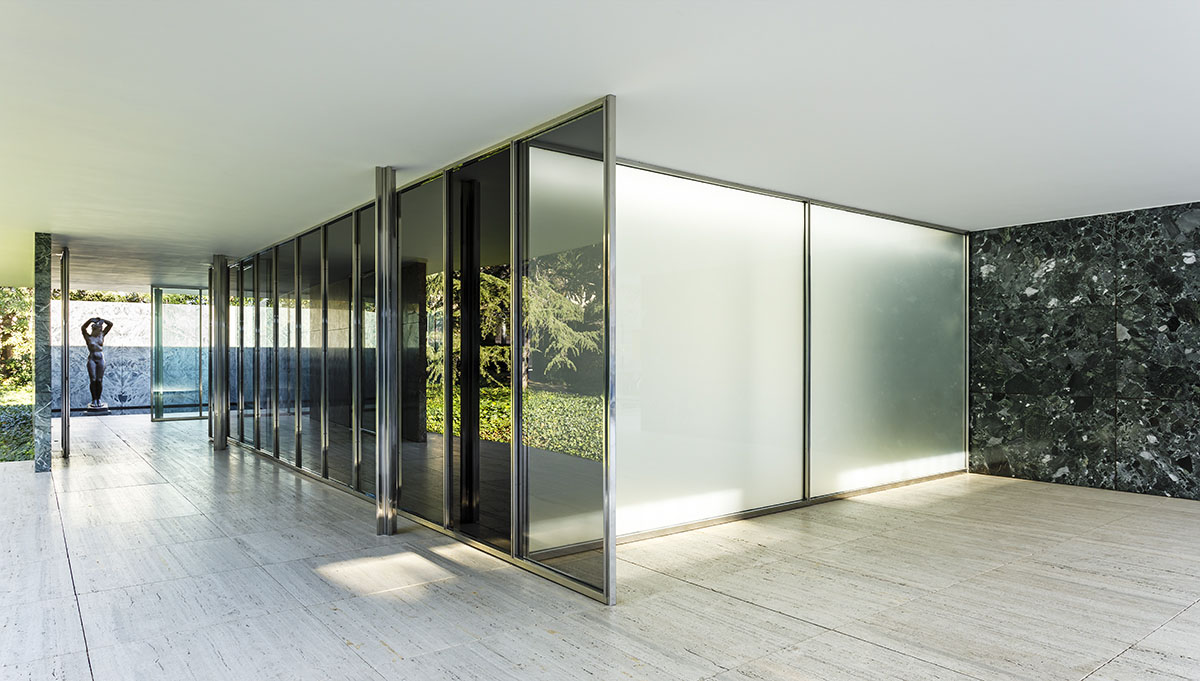
Mies van der Rohe Pavilion. Image © Marcela Grassi
LINA
Collaboration with invited participants
Mies van der Rohe Pavilion
April
The Mies van der Rohe Foundation participates in the European architecture platform LINA by collaborating with leading emerging voices. This connection with emerging architectural practitioners and thinkers allows to orient architecture towards sustainable, circular and clean practices, linking often little-known existing efforts with this international platform consisting of architecture museums, universities, research networks, foundations, triennials, biennials and other high-level European and Mediterranean architectural organizations.
Each year, LINA participants are offered the opportunity to be part of the Fundació Mies van der Rohe program through conferences, workshops, mentoring or other collaborative formats, helping their ideas reach further and gain an international audience. Looking ahead to 2023, the teams Palace of Un/Learning (Bernadette Krejs and Max Utech), “zwkr” (Kateřina Krupičková and Martin Zwahlen) and Space Saloon + The MAAK (Max Melvill, Rebecca van Beeck , Danny Wills and Gian Maria Socci) have been invited to participate in the framework of "Model. Festival de Arquitecturas de Barcelona". In autumn, the winners of the EUmies Awards Young Talent 2023 will be part of the 25 teams chosen to present their proposals to the LINA meeting in Ljubljana, from which all participating institutions will have the opportunity to listen to them and collaborate with them in their activities. LINA is made possible thanks to the support of the Creative Europe program of the European Union.
Architecture and the Media. EUmies Awards
April
The European Conference on Architecture and the Media is conceived as a place to meet and exchange experiences on the dissemination of architecture. It is aimed at journalists, cultural organizations and institutions, communication professionals, architects and architecture lovers. This third edition will take place within the framework of the Model. Barcelona Architectures Festival and will emphasize the dissemination tools that social networks offer and how they change the new communication opportunities.
SónarMies. Artistic Intervention
June
The sound interventions in the Pavilion have had a reserved space over the years in the framework of SónarMies with the will to stimulate critical reflection and generate new looks where the Pavilion is a space of inspiration and experimentation for the most innovative sound creation. In this way, the Pavilion becomes a research laboratory that opens, just a few days before the start of the Sónar festival, to the latest proposals in the field of sound creation.
Rocking the Accident
Stella Rahola and Roger Paez - Elisava
Mies van der Rohe Pavilion
22-29 June
The students of the Master's degree in Ephemeral Architecture and Temporary Spaces of Elisava (MEATS), led by professors Stella Rahola Matutes and Roger Paez, propose a re-reading of Ludwig Mies van der Rohe and Lilly Reich's Pavilion from its constituent materials. Following the project 'Beautiful Failures' (2019-2021) - which questioned the fragility and vulnerability from the two most delicate materials of the construction of the Pavilion: glass and travertine - in this second part, students will start from the travertine slabs they cataloged and work to reflect on the changes that transform materials by natural effects. The growth of mosses and lichens on the stones of the pavilion is often interrupted by maintenance tasks that seek to give the Pavilion an aspect of invariability that corresponds to its mythical and prefixed image. The effect of the garden's biotope on the Pavilion's materials and the links with other organic agents create an imbalance, a tension, which can produce a change because matter is never stable.
Pantalla Pavelló
Summer film series
July 3rd, August 7th and September 4th
'Pantalla Pavelló' is the film series, projected directly onto the travertine of the Mies van der Rohe Pavilion that delves into the relationship between the built space, its limits and boundaries, and the inhabitants who reside in it, and how this relationship is accentuated and revealed in its fullest expression. Architecture, and with it cities, determines and influences the way we live in the same way that our rules of coexistence and the laws that regulate societies do. A reflection on the built space that surrounds us, the cities we want and, therefore, the society we desire. This year, Copenhagen is the world capital of architecture, and the Fundació Mies van der Rohe will collaborate with the Copenhagen Architecture Festival (CAFx) to choose the three films for the summer cycle. The goal of CAFx is to challenge the field of architecture and promote critical thinking, inspiring, engaging and raising public awareness of how architecture and urbanism shape our lives and the world, and vice versa: how our cultures, ideologies and immaterial practices affect space. These shared objectives and the importance of their own film series reinforce this collaboration, which also converges in the European architecture platform LINA.
"The cost of money: raft", Mark Cottle
Mies van der Rohe Pavilion
3-14 July
"The cost of money: raft” is a meditation on the high prices of human capital, especially for the most vulnerable populations, and at enormous expense to the environment. Mark Cottle, trained in English literature, musical composition, architecture and painting, and theory and criticism, makes the work for this project from disposable plastic bags collected from the garbage garbage can. Each shopping bag represents a transaction, or group of transactions, the tangible residue of goods consumed. Sometimes folded, stored and used again. Often discarded. It also indexes a myriad of smaller, informal economies, operating below the surface of the main one, such as corner stores and small businesses brought in by relatives or newcomers. Available in bulk, by the kilo, the bags often come from a series of interlocking immigrant business communities. Starting with a residency and exhibition of installations at Neutra VDL House in Silver Lake, Los Angeles, 'The cost of money', seeks to be an ongoing project in dialogue with a series of iconic works of modern architecture.
While the buildings share compositional, spatial and tectonic strategies, each has its own particularities in terms of location, materials, textures, colors and dimensions, that require a specific and individual formal response for each artistic intervention.
"Psicoarquitectura", Óscar Abraham Pabón Barcelona Gallery Weekend
Mies van der Rohe Pavilion
from September 14 to October 8
The proposal approaches the constructive materiality of the Pavilion from its interpretative and psychological dimension. The proposal is based on a relationship by resemblance between the ink stains proposed by Hermann Rorschach and the surfaces of the walls that make up the Pavilion. From there, three independent brick walls are built, joined with mortar, on which the drawing of three new stains will be traced. The walls become objects of interpretation, and their surfaces somatize an internal dimension that implies both the constructive history of the material and its role in twentieth- century architecture and urbanism. If the 1929 Pavilion symbolized the future of the modern house, "Psicoarquitectura" will offer an interpretation of the future of this modernity from a psychic and somatized dimension. Intervention in the framework of Barcelona Gallery Weekend.
New Temporalities
October
The Fundació Mies van der Rohe participates in the European project "New Temporalities" with cultural and academic institutions from seven European countries: Lisbon Architecture Triennial, Tbilisi Architecture Biennial, Barleti University in Tirana, Dekabristen e.V. in Berlin, the APSS Institute in Podgorica, the Pavilion Kultury in Kiiv and the Trans-Media-Akademie Hellerau e.V. in Dresden, Germany.
The program aims to strengthen architectural culture throughout the continent, documenting, researching and highlighting common temporal spaces and questioning the notions of permanence and stability associated with the spatial dimension of architecture. Work will focus on everyday temporalities. The participating teams will meet in Barcelona in autumn to learn about situations of temporality in the city, from places originally created as temporary, such as the Pavilion itself where ephemeral interventions are currently taking place, to emergency housing and new ways of living together in the city. New Temporalities is possible thanks to the support of the Creative Europe program of the European Union.
El Marge
Terence Gower
Mies van der Rohe Pavilion October 19 to November 5, 2023
‘El Marge’ uses period literature and music to give visitors insight into the urban cultural context of the original pavilion: Barcelona in the late 1920s and early 1930s. World fairs are strange events. Countries from around the world create elaborate displays that offer the world a cleaned-up, idealized version of themselves. These displays are built in a sort of ideological no-man’s-land set up by the host country and often walled off from the living city. Architecture has flourished at these sites – some would say “true” architecture, unburdened by functional concerns.
Mies van der Rohe in Barcelona in 1929, Alvar Aalto in Paris in 1937, Oscar Niemeyer in New York in 1939, to name just a few of the exhibition pavilions that became icons of 20th century architecture. My project rewinds the clock to the era when Mies’ pavilion was originally built and stages a retrospective experiment where the gritty urban culture of the Barcelona of this period, a wild political and cultural whirlpool, insinuates itself into the pristine, aspirational mircrocosm built on the slopes of Montjuïc. This nearly invisible intervention functions formally in a subtle and largely ephemeral manner. The intervention consists of four elements: a nearly transparent photograph applied to the glazing overlooking the small pool; a carefully choreographed musical performance, a perfume diffusion; and a newspaper pamphlet featuring period documentation and many of the literary and journalistic artefacts from the artist’s research. Each of these elements subtly “contaminates” the pavilion by introducing some of the drama and messiness of that other city – La Barcelona Canalla – into the pristine form of Mies’ masterpiece. The proposed title of the intervention, the Catalan for “margin,” connotes the boundary between the worlds of the Barri Xino and Montjuïc and the notion of le marginal, the French term for someone living on the margins of society.
"Politics and Architecture", Dietrich Neumann
Mies van der Rohe Pavilion
From November 9th to 26th
Dietrich Neumann, one of the great experts of the Mies van der Rohe Pavilion makes an intervention in the Pavilion that sheds light on the complex political context of its genesis and execution and also in relation to its representative role. By introducing some elements that have not been visible with the 1986 reconstruction, he points out to us that the Pavilion was by no means a simple representation of the young democracy of the Weimar Republic, but was equally acceptable to people like Georg and Lilly von Schnitzler and their friends from the European Cultural Association, which held its annual conference in Barcelona in the fall of 1929. The von Schnitzlers helped finance the pavilion and were opponents of the Weimar Republic and its political leanings closer to that of the German Empire.
There are only a few photos of the 1929 pavilion, and they are all in black and white. These photographs represent mainly the day of the inauguration and a smaller number of them sporadic moments that took place later and coincided with moments such as the meeting of the European Cultural Association. In the photos we find differences such as the large flags that were used as flagpoles in the Pavilion, the incorporation of the red curtain in July and the word "Germany" that appears next to the steps and on the travertine wall that opens onto the garden. The flag of Germany, the one the country still uses today, had only recently been introduced, in 1919, with the founding of the Weimar Republic. However, many conservatives, including members of the German Volkspartei (DVP), to which Stresemann, Curtius and probably von Schnitzler belonged, still preferred the flag of the previous regime, with its black, white and red stripes, which for them symbolized the strength, achievements and stability of the Kaiserreich that had come to an end in 1918. They associated the new flag with a "defeatist spirit" and Germany's loss of sovereignty and power with the Treaty of Versailles. In Barcelona both flags (which looked huge) were hoisted in front of the German pavilion, which led to confusion among many visitors, who wondered which was the real German flag.
Presentation of the publication "Re-enactment: Lilly Reich's work occupies the Barcelona Pavilion", Laura Martínez de Guereñu
December
Laura Martínez de Guereñu's research project that merited the Lilly Reich Grant for Equality in Architecture in its first edition - which resulted in an article that was published in Grey Room and a striking intervention in the Mies van der Rohe Pavilion in 2021 - is now embodied in a catalog that joins the Fundació Mies van der Rohe collection of publications and adds to the knowledge and prolific results to which the Grant has contributed to.
Open doors and audio guide
January 1, February 5 and 12, March 5, April 2 and 23, May 7 and evening of May 13, June 4, July 2, August 6, September 3 and 24, October 1, 7 and 8, November 5, and December 3. To make the Mies van der Rohe Pavilion accessible to everyone, the Foundation is offering a series of open days that allow visitors to visit the iconic building designed by Mies van der Rohe and Lilly Reich with the audio guide free of charge without having to book or buy an entrance ticket.
These open days include the first Sunday of every month throughout the year as well as the city's festivities such as Santa Eulàlia, Sant Jordi where the pavilion becomes a reading pavilion and La Mercè which hosts family workshops as well as the Night of the Museums where we join this international event and open the doors when it gets dark and the weekend of Viu Montjuïc, the culture park in which the facilities jointly propose a weekend of activities for everyone.
Top image courtesy of Fundació Mies van der Rohe.
